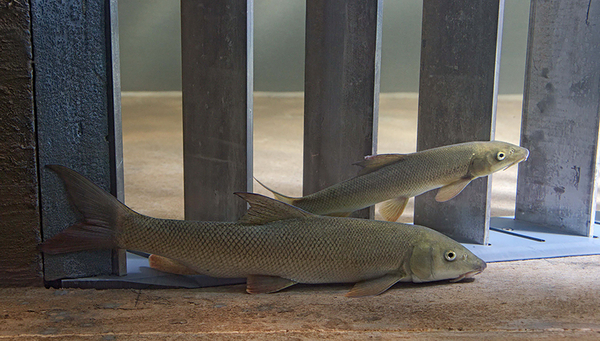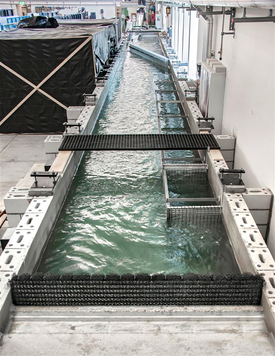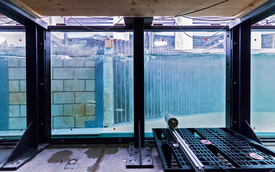News Detail
Downstream passage facilities with signals that are understood by fish
December 17, 2020 |
For over 100 years, fish ladders have been fitted to hydro-electric plants and other obstacles in order to assist migrating fish, but there is a distinct lack of downstream passage facilities that actually work in practice. The reason for this is that, because fish follow the strongest flow, they struggle to find the weak flow that leads to the safe bypass. As a result, most of them end up in the turbines of the power station along with the main flow, resulting in injury or death – especially in the case of large fish and eels, which are particularly long.
Trouts scanning the flow at the rack. (Excerpt from the video “Downstream”; more information at the end of the article).
Communicating with fish
“We asked ourselves how we could influence the behaviour of fish so that they would swim into the bypass,” explains Claudia Beck, who is doing her doctorate at the Laboratory of Hydraulics, Hydrology and Glaciology (VAW) of ETH Zurich and has now published a chapter of her thesis in the journal Water. As part of an interdisciplinary team made up of hydraulic engineers from VAW as well as fish biologists from FishConsulting GmbH and the Swiss Federal Institute of Aquatic Science and Technology (Eawag), Beck has been working on a rack to send the correct signals to fish, and testing this system at VAW.
The rack developed by Beck and her team is placed in the water upright – diagonal to the flow – and stretches from the opposite bank to the bypass entrance. Unlike in conventional debris racks, the bars of this fish guidance structure do not have a straight profile; rather, they are slightly curved towards the direction of flow. Although the bars are far enough apart (typically 25–100 mm) for most fish to swim between them, they are aligned to create significant pressure and velocity differences within the water – and thereby to send a strong “signal” to the fish. With their fins and lateral line organ, fish have a very sophisticated perception of flows and pressure differences.
Every species reacts differently
The researchers tested their new curved-bar rack (CBR) system in a laboratory flume equipped with five immersed cameras. This setup allowed them to establish not only whether the flow signals helped the fish to find the bypass, but also how the animals behaved. “We found that different species dealt with the rack in very different ways,” says Eawag biologist Oliver Selz. For example, nase, barbel, brown trout and Atlantic salmon parr used their caudal fins to explore the spaces between the bars. However, whereas a quarter of brown trout swam through the rack after inspecting it, this was very rarely the case with salmon parr and nase.
Overall, the rack was very effective at guiding four of the six tested species – barbel, spirlin, nase and Atlantic salmon parr – to the bypass. Of the brown trout, about half responded as desired, while the eels showed no reaction at all to the rack. For rivers that are home to eels, the researchers therefore recommend that the CBR only be used in combination with bottom overlays or even electric fields – signals to which eels respond well. Electrified CBRs have so far only been trialled in an experimental setting.
The first pilot projects with adapted variants of the CBR are planned to be introduced at the power plants of Herrentöbeli (on the River Thur) and Bannwil (on the River Aare). At the same time, further laboratory experiments are underway with a view to making improvements.
694 obstacles to downstream movement
Over half of all fish species in Switzerland are threatened by extinction. This is partly due to hydro-electric plants and weirs, which hinder or even prevent the migration of fish between their various habitats. The Swiss Waters Protection Act (WPA) therefore requires that these installations be adapted to allow the passage of fish by 2030. This requirement applies to 659 obstacles to upstream movement and 694 obstacles to downstream movement.
Spirlins in front of the CBR fish guidance screen in the trial installation at VAW. In total, the channel is 30 m long, 1.5 m wide and 1.2 m deep.
(Photo: VAW)
Coverpicture: Eawag. Armin Peter



